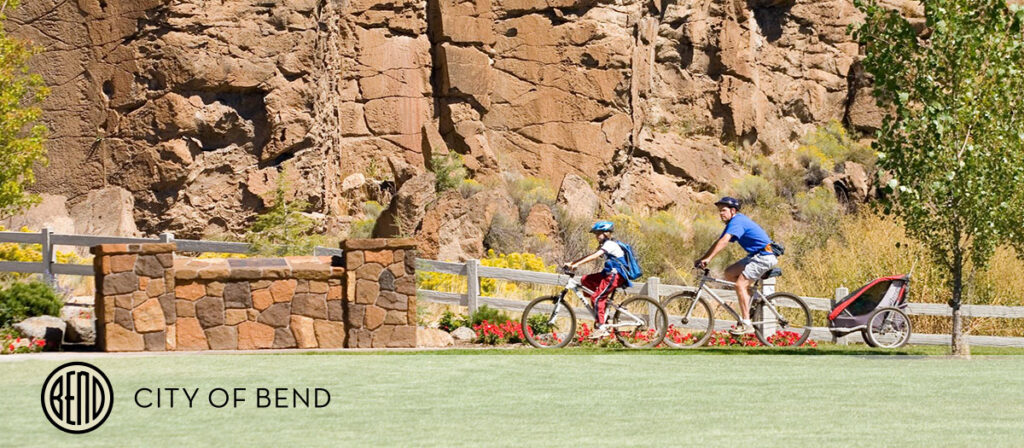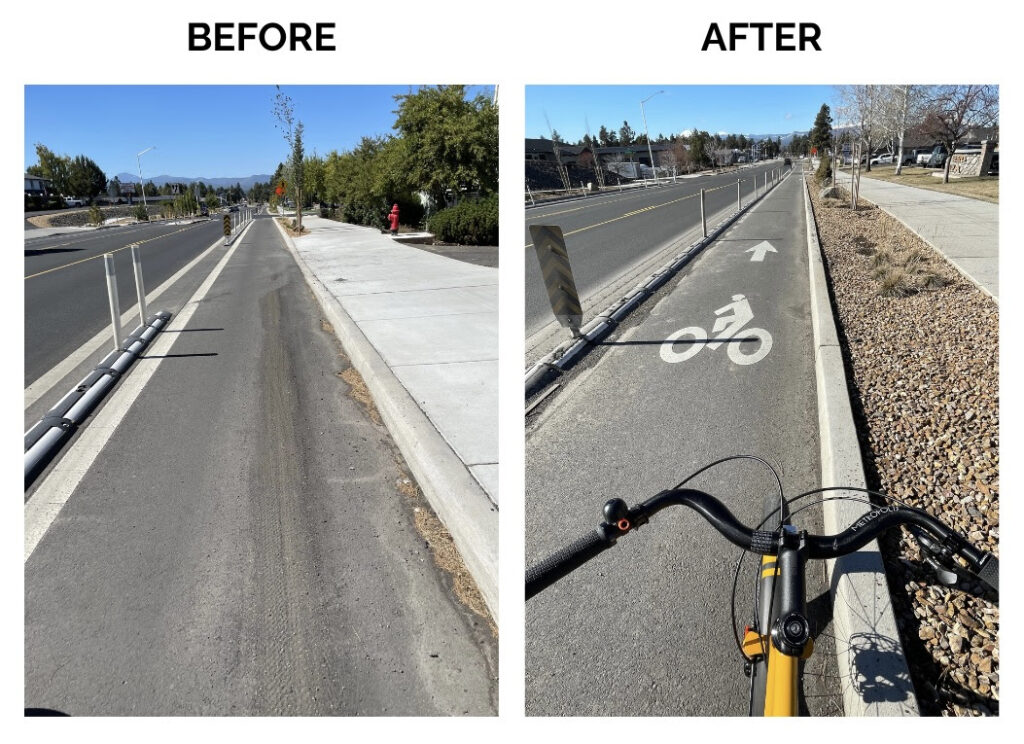The extra day this month isn’t going to waste! Get involved in making Bend a safer and more enjoyable city to walk, bike, and roll in by providing input on the Bend Bikeways Project. Read on to learn more about what it takes to keep our transportation facilities clean and well-maintained.
City Happenings

[Photo credit: City of Bend] Two people riding bikes in a park.
Provide Input on the Bend Bikeways
Once established, the Bend Bikeways will be two safe and connected bike routes across Bend, one from north to south and one east to west. This has been a city council priority for the last few years and is currently in the planning stage. Now is the time to help make sure the bikeways are well-connected, safe, and comfortable. Provide your input at the in-person Open House on February 29 from 5:00-7:00PM at the Municipal Court Building at 555 NE 15th St. If you can’t make it to the in-person event, review the plans and complete the feedback survey online via the Virtual Open House.
Wilson Avenue Protected Bike Lane – Free of Gravel
One of the fears we hear about protected bike lanes is that they will be so clogged with gravel and debris that they will be unrideable. The city is working hard to make sure that this doesn’t happen and recovery from the recent storm is an example. After several inches of snow last month, the street thoroughly graveled, and the snow gone, the bike lane did indeed have too much gravel to make riding comfortable.

Photo credit: Henry Able; Wilson Ave. Protected lanes
The maintenance crew brought out their new Bobcat with the sweeper attachment and a crew of backpack blowers. The result, even after plowing out the next storm cycle and with the snow still melting off, the protected lane on Wilson Avenue looks pretty good.
The city has two new Multihog sweepers on order. They will make this job easier and with the Transportation Utility Fees available next year, the city crews should be able to keep up even better. While we hope to see cleaning debris from bike lanes prioritized in the maintenance schedule, you can also alert the City to areas of greatest need by submitting a service request. And if you see the new sweeper crew working to clean up the bike lanes, give them a wave and a thumbs up!
Narrow Streets – Safer! Cheaper! Greener!
Narrow streets bring many advantages. They are safer for all street users. They are cheaper to build and maintain. They provide environmental benefits including less storm runoff and space for more trees. And, as a bonus, they can reduce unproductive space used by streets and free it up for housing or other purposes.
The city will be revising our street standards this year. Bend Bikes will be working to narrow our streets to make them safer, cheaper, and greener.
There are three dimensions of narrow streets: narrower lanes, fewer lanes, and narrower right-of ways. All have benefits which build on each other. Here are several articles explaining the benefits of narrow streets.
- Elisa Cheng of Bend Bikes provided a general overview of narrow streets in a Guest Opinion in The Source Weekly on February 8, 2024.
- Johns Hopkins Bloomberg School of Public Health recently released a major study about safety and lane width, which concluded that, in cities, narrow lanes of 9 to 10 feet are safer for all users: people walking, people on bikes or rolling, and people driving.
- The National Association of City Traffic Officials recommends lane widths of 10 feet on city streets.
- An analysis of costs associated with lane width is provided by the Strong Towns article “Reconstructing the Street? Move the Curb!” It also summarizes the non-financial benefits of narrower streets.
Why are narrower streets safer? It’s primarily about speed. The wider the street appears, the faster people drive. Importantly, the perceived width is not the space between the lane markers. For example, parking lanes without parked cars and painted bike lanes both make the street look wider to a driver. The faster people drive, the more likely a crash and a serious injury. What makes speed dangerous? It takes longer to stop when traveling at higher speed, and it narrows the driver’s field of view so they’re less likely to see a person in a crosswalk or the side of the street. If someone is hit by a car, they are more likely to die if the car is traveling fast. The largest increase is between 20 mph, at which about 20% of people die, and 30 mph, at which speed about 80% of people die.
Until recently, Bend’s street standards for our major streets specified lane widths of 12 feet and some of our major streets still have lanes that wide. The standards currently call for 11 foot lanes. It’s true in Bend as it is elsewhere: wider streets lead to higher speeds. We all see cars regularly moving much faster than the posted speed limit with the resulting crash record to go with it. In 2023, our police responded to 2,333 motor vehicle crashes including at least 191 injuries.
How are narrower streets cheaper? Wider streets are more costly to maintain. Bend is instituting a Transportation Utility Fee because we can’t afford to take care of our streets with our current funding.
How are narrower streets greener? Our transportation system in Bend is not yet resilient to the impact of severe weather events. After major storms we commonly see local flooding on our streets because we have so much impermeable surface, including streets. We also have a significant heat island effect, recently ranking in the top 20 of US cities. Heat islands form where there is limited greenery and a high density of heat-absorbing urban materials, such as concrete, asphalt, and buildings.
While none of these problems will be completely resolved by narrower streets, narrower streets will contribute to reducing all of them.
Our Favorite Bike Routes
Bikey Book Club

[Photo by Olena Sergienko on Unsplash ] Books in a pile at the library
Next Meeting: March 25, 6:30pm
The Bikey Book Club met on Monday to listen to and discuss There Are No Accidents: The Deadly Rise of Injury and Disaster – Who Profits and Who Pays the Price by Jesse Singer. Ms. Singer’s major point is that we’ve long regarded “accidents” as the fault of “the nut behind the wheel,” “the accident prone worker,” “the jaywalker,” or similar disparaging terms when “accidents” are actually predictable and preventable by changing dangerous conditions. It doesn’t matter whether these dangerous conditions are found on our streets and roads or in our mines and factories. When dangerous conditions are reduced, deaths and injuries decline.
Some of the points we discussed are how race and wealth affect rates of death and injuries. Black and Brown people are more likely to be killed or injured than White people in any potentially dangerous environment. Wealth protects people because they can avoid dangerous situations and buy equipment to protect themselves. Corporations and industry groups have a role in exacerbating the situation because they so often oppose safety regulations and enforcement of these regulations. We all agreed that this book changed the way we see and should talk about “accidents.”
We’ll be meeting on March 25 to watch a video related to our next book, Bikenomics: How Bicycling Can Save The Economy by Elly Blue. Blue compares the economies of cities dominated by cars with those that have room for people outside of cars, on foot and on bike.
Please join us when we meet on March 25th–there is no need to pre-register. Contact [email protected] or [email protected] for more information.
Upcoming schedule: Downtown Bend Library, Meyers Room
- Mar 25, 6:30-7:45; Bikenomics: How Bicycling Can Save The Economy by Elly Blue
